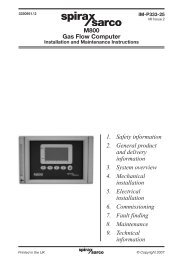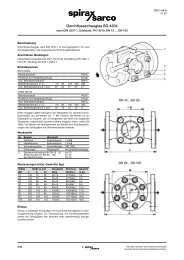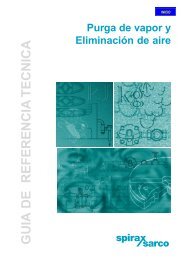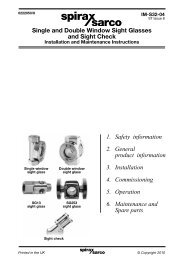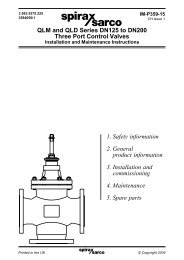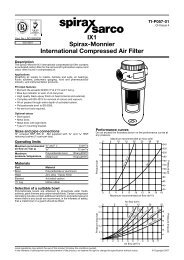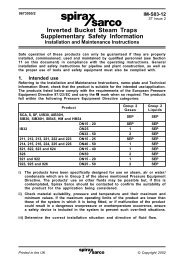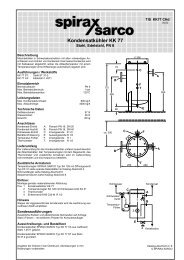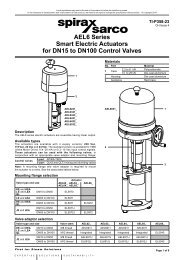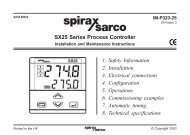2000 Hook-up Book - Spirax Sarco
2000 Hook-up Book - Spirax Sarco
2000 Hook-up Book - Spirax Sarco
Create successful ePaper yourself
Turn your PDF publications into a flip-book with our unique Google optimized e-Paper software.
SYSTEM DESIGN<br />
38<br />
Steam Trap Selection<br />
A full discussion of steam trap<br />
functions are found in the companion<br />
Fluid System Design<br />
volume, “STEAM UTILIZATION.”<br />
The material covers operation of<br />
all types of traps, along with the<br />
need for proper air venting and<br />
trap selection. Traps are best<br />
selected not just on s<strong>up</strong>ply pressure<br />
and load requirements, but<br />
after reviewing the requirements<br />
of the application compared to<br />
trap characteristics including discharge<br />
temperature, air venting<br />
capability, response to pressure<br />
and load change, and resistance<br />
to dirt, corrosion, waterhammer<br />
and freezing conditions.<br />
Answering these questions leads<br />
to the selection of the most<br />
appropriate generic type of trap<br />
and the general recommendations<br />
found in Table 11 reflect this.<br />
This Selection Guide covers most<br />
trap uses and the recommended<br />
type can be expected to give satisfactory<br />
performance.<br />
Condensate removal was needed from 3 polyvinyl butyral<br />
extruders at a pressure of 240 psi. Application required<br />
that a consistent temperature be maintained the length of<br />
the extruder to provide product quality in the melt. There<br />
were nine sections per extruder.<br />
The customer had used various brands of traps and<br />
trap styles to drain the extruders. Most recently they used<br />
a competitors bimetallic trap. They were experiencing<br />
inconsistent temperatures throughout the length of the<br />
extruder because the bimetallic traps subcooled the condensate,<br />
which then backed <strong>up</strong> into the heat transfer area.<br />
They were also experiencing high maintenance costs in<br />
relation to these traps.<br />
Steam Trap Sizing<br />
Steam main drip traps shall be<br />
sized with a 2 times safety factor<br />
at full differential pressure. In<br />
most cases, they will be 3/4” size<br />
with low capacity orifice or smaller<br />
unless otherwise shown on the<br />
drawings and they shall be located<br />
every 200 feet or less. Traps<br />
for steam tracing shall be 1/4" to<br />
1/2" size. They shall be located<br />
every 100 feet or less. Radiator<br />
traps shall be pipe size. Freeze<br />
protection traps shall be 1/2" to<br />
3/4" size unless otherwise noted.<br />
Traps for equipment drainage<br />
are sized with safety factors that<br />
reflect the differences of the<br />
HVAC and Process industries,<br />
such as variations in actual<br />
hydraulic head and material construction<br />
of tube bundles. A<br />
summary of these typical recommendations<br />
are as follows:<br />
HVAC Industry<br />
• Non-modulating control systems<br />
have traps selected with<br />
a 2 times factor at full pressure<br />
differential.<br />
• Modulating control systems<br />
with less than 30 psig inlet<br />
pressure have traps selected<br />
Case in Action: Polyvinyl Butyral Extruders<br />
for full-load at 1/2 psi pressure<br />
differential, provide 18 to<br />
24" drip leg for condensate to<br />
drain freely to 0 psi gravity<br />
return. (With drip legs less<br />
than 18", consult a <strong>Spirax</strong><br />
<strong>Sarco</strong> representative.)<br />
• Modulating control systems<br />
with greater than 30 psig inlet<br />
pressure have traps selected<br />
with a 3 times factor at full<br />
pressure differential for all<br />
preheat coils, and a 2 times<br />
factor for others.<br />
Process Industry<br />
• Non-modulating control systems<br />
have traps selected with<br />
a 2 times factor at full pressure<br />
differential.<br />
• Modulating controls systems<br />
with less than 30 psig inlet<br />
pressure have traps selected<br />
for full load at 1/2 psi pressure<br />
differential, provide 18 to<br />
24" drip leg for condensate to<br />
drain freely to gravity return<br />
at 0 psi. (With drip legs less<br />
than 18", consult a <strong>Spirax</strong><br />
<strong>Sarco</strong> representative.)<br />
• Modulating control systems<br />
have traps selected with a 3<br />
times factor at full pressure<br />
differential.<br />
Solution<br />
Float & Thermostatic steam traps were recommended for<br />
draining the extruders. This would give them immediate<br />
condensate removal; therefore maintaining a consistant<br />
temperature throughout the length of the extruder, providing<br />
better control over product melt. Also, <strong>up</strong>on<br />
recommendation, strainers were installed before the traps<br />
to help keep dirt out, and cut down on maintenance cost.<br />
Benefits<br />
• Maintained consistent temperatures with existing equipment<br />
because there is no condensate in the heat<br />
transfer area.<br />
• There is less maintenance cost due to the strainers<br />
installed before the traps.



